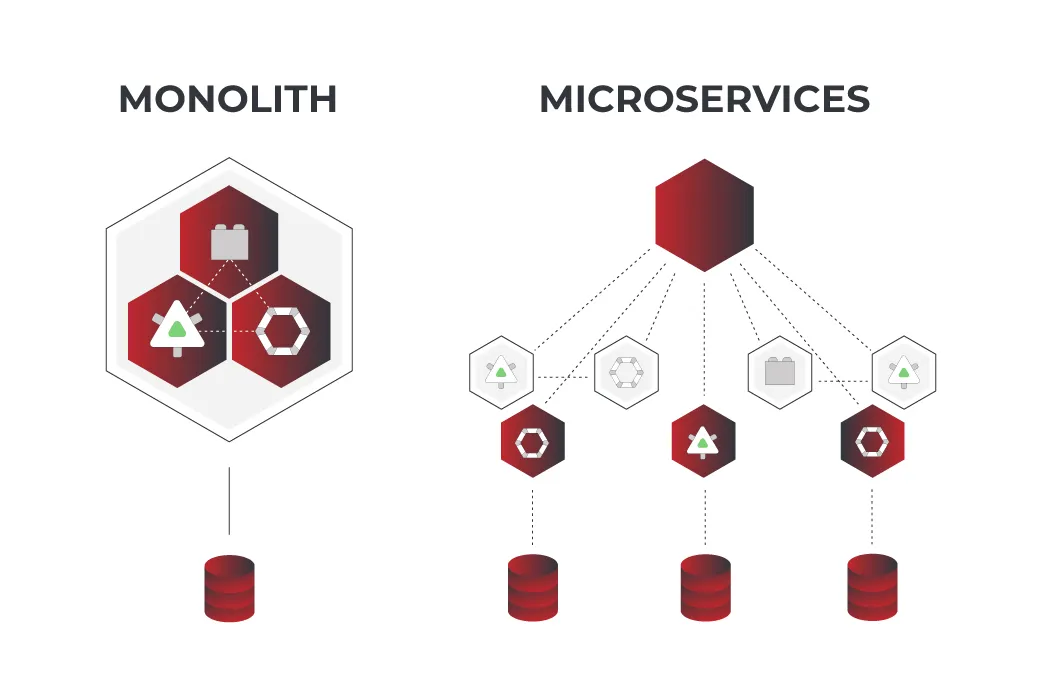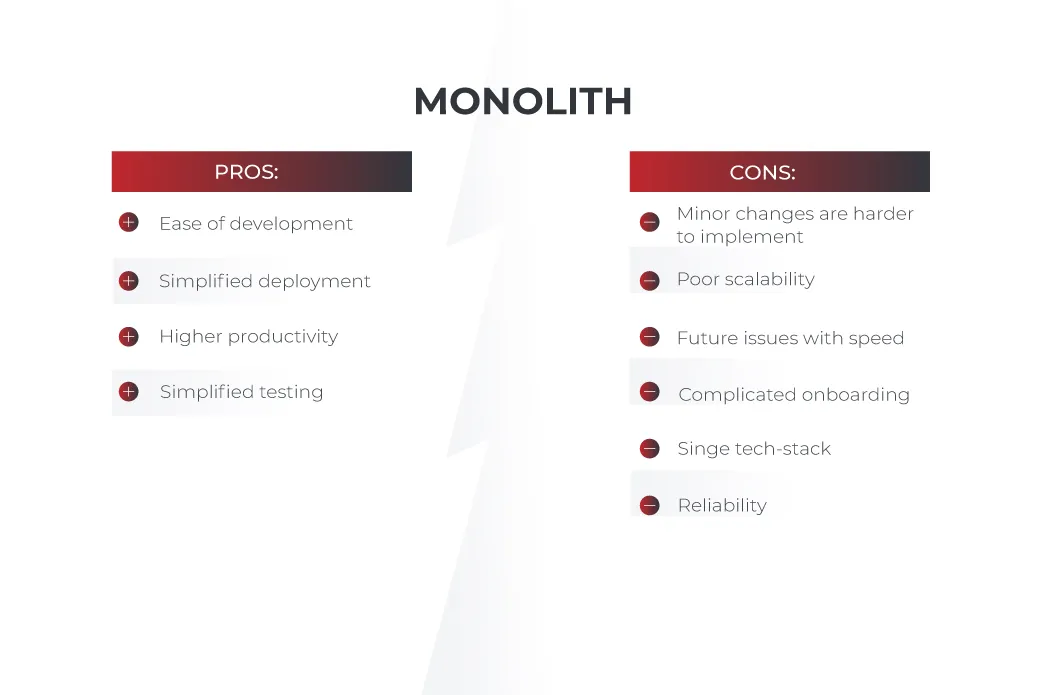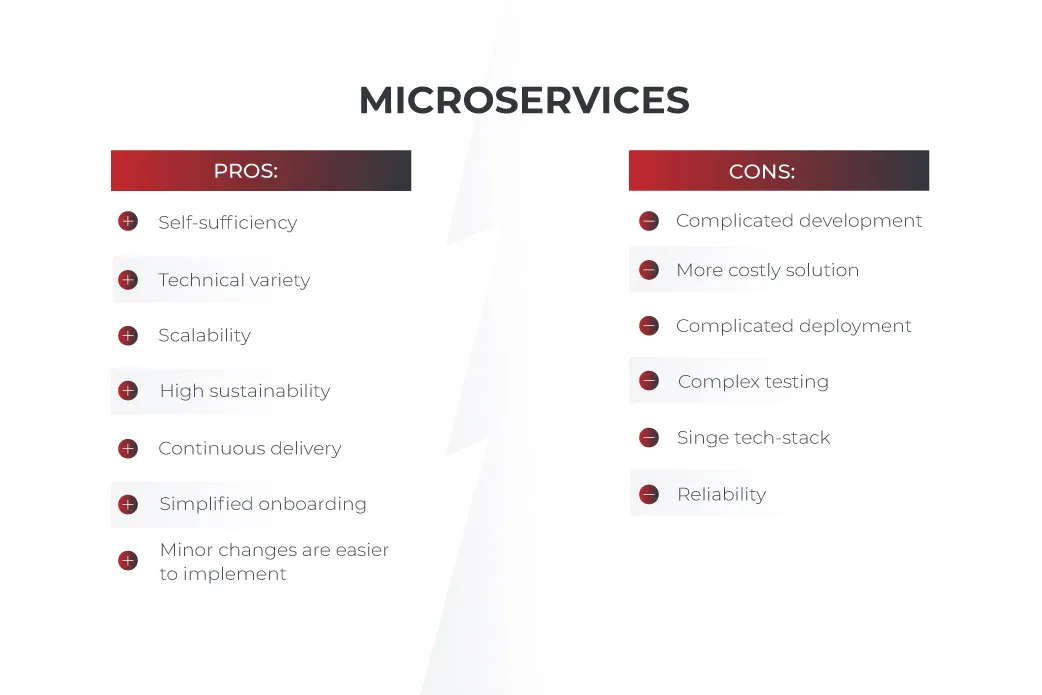Monolithic architecture vs microservices: strengths and weaknesses


In the context of ever-increasing competition in almost all areas of digital business, the speed and continuity of business-oriented service delivery are becoming a key factor influencing the customer’s choice in favor of a particular solution. The widespread adoption of the DevOps philosophy to ensure continuity of delivery and updates without sacrificing quality is also a result of current market trends. In such a situation, there can be no trifles; therefore, the code & app architecture question was called into a debate. The result was a gradual shift away from the time-tested monolithic architecture in favor of a more agile microservices architecture approach.
Monolithic vs Microservices comparison
In order to understand the difference between monolithic architecture and microservices architecture and why more and more companies prefer microservices while monolithic architecture is still in demand, we need to compare both approaches in terms of their essence and purpose.

What is Monolithic architecture?
You can check monolithic architecture in a solid application with a single code base presented as a single unit file. Such a system works as a whole, solid product, and it interacts with a single database. The client interface, database, front and back end, and the business functions of the application are presented in one place, don’t interact through the APIs, and are definitely part of a single-tier architecture monolithic application.
This is the traditional software development model for building applications that all of us have come across. Even though modern trends are forcing digital companies to increasingly make their choice in favor of a microservices architecture, the monolithic architecture approach still has its advantages.
Monolithic pros
- Ease of development. Monolithic architecture is a standard, long-studied approach that does not require any additional skills from developers or managing multiple technology stacks.
- Simplified deployment. The entire system is uploaded as a single unit, and therefore, engineers do not need to worry about unloading various services combined through the third-party API, which reduces deployment complexity.
- Higher productivity. A somewhat controversial point, but there is an opinion that the monolithic applications run faster due to the absence of a large number of microservices combined through the network communication protocol. Nevertheless, it all depends on a number of additional parameters.
- Simplified testing. Another advantage of a monolith structure—automated tests can be run with no worries about the need for a separate testing algorithm for each service, avoiding debugging challenges common in distributed systems
Monolithic cons
- Poor scalability. As the application grows, its size increases, making it more difficult to understand and scale, especially when relying on vertical scaling.
- Minor changes are harder to implement. You have to re-deploy the entire system even for small fixes, which is resource-intensive and increases operational overhead.
- Future issues with speed. As an application grows in size, its deployment and launch times also increase.
- Complicated onboarding. It is difficult for newcomers to understand a huge unified unit application, even if their tasks include working with only certain limited functionality. Over time, with the growth of the application size, this problem only gets worse.
- The application has a single tech stack. This means that the process of new technology implementation (in order to improve the work of some particular function) becomes extremely difficult due to limitations in technology stacks.
- Reliability. One of the main disadvantages of monolithic architecture. A critical error can possibly break down the entire system.

As you can see, despite a number of advantages, monolithic architecture has its significant drawbacks, so it is not surprising that companies increasingly prefer microservices architecture. However, this situation has its own nuances.
What is Microservices architecture?
In contrast to the monolithic architecture approach, in the microservices architecture, the application structure is split into separate, small, independent services, which are often defined only by business functions and interact with each other through HTTP requests or third-party APIs. Each of these services has its own database, which allows you to ensure the continuity of the business-oriented services delivery and their independence, as well as prevent loss of quality and data in a distributed architecture. Microservices architecture is very important for those companies that are going to implement DevOps methodology, ensuring the continuity of delivery of their services via cross-functional teams. However, this architecture has its pros and cons.
Microservices pros
- Self-sufficiency. Each individual micro-service can be built to provide a specific business function goal and work completely independently from the rest of the microservices, enabling independent scaling.
- Technical variety. Unlike monolithic architecture, where the selected stack is final and does not tolerate any changes, with the microservices architecture you will have the opportunity to select a separate stack for each service, improving productivity through flexible technology stacks.
- Scalability. One of the main advantages of microservices over monolithic is that they are so popular these days. Due to the dispersed system of independent services, the system as a whole is extremely flexible and capable of expanding through changes in individual services with independent scaling rather than relying solely on vertical scaling.
- High sustainability. Each of the microservices works autonomously, and therefore, any errors in one of them will not affect the work of others, thereby increasing the reliability of the distributed computing network system as a whole.
- Continuous delivery. Due to the autonomy of independent services and modules, customers can receive permanent value, while you can always make changes to specific services without stopping the system as a whole.
- Minor changes are easier to implement. You don’t need to stop and re-deploy the entire system for small changes, which reduces deployment complexity.
Simplified onboarding. Newcomers can jump on a specific microservice and immediately get into work, so they do not need to examine the entire system, making cross-functional teams more agile.
Microservices cons
- More complicated approach. Developing a microservices architecture requires in-depth knowledge from software engineers, especially in terms of establishing connections between microservices and managing APIs.
- Greater resource consumption. Microservices architecture often requires not only more effort but more development time and manpower, which may not suit some companies and adds to operational overhead.
- Complicated deployment. A large number of stand-alone services and connections between them require a greater effort from developers to deploy the app, increasing deployment complexity.
- Complicated testing. Of course, a more complex system consisting of disparate services created using different technology stacks requires a more thorough approach to testing. Running a few automated scripts through the entire system will have no effect in such a situation due to debugging challenges across a distributed architecture.

Can’t choose the right architecture? Opt for:
When to opt for monolithic architecture?
Despite the growing demand for microservices architecture, the monolithic architecture approach still makes sense if:
- The app will be small. It will be easier and faster to develop a monolithic architecture for a small product.
- There are no team and product expansion plans in your mind. The expanding process is expensive and undesirable with a monolithic architecture.
- Your product isn’t developed yet, and you’re at the startup stage. Developing a monolithic architecture will take less time than creating many microservices.
- You need a minimum viable product (MVP) with a key value to validate your idea and collect feedback—monolithic architecture is your choice.
When to opt for microservices architecture?
Microservices architecture is the choice of large companies and businesses that want to expand and meet the growing needs of their customers. Tech giants like Amazon and Spotify have long since switched to microservices architecture. This approach is also suitable for you if:
- The future product will be large and will have a lot of features and services.
- The team has time to thoroughly study and map out the entire development process.
- The team and product will expand in the future, implementing new specialists and technologies.
- The use of different tech-stacks for specific services is crucial.
- The budget is not an issue. You aren’t afraid of higher costs and want to create a feature-rich product that will have separate teams working on it.
Monolithic vs Microservices architecture comparison
To finalize monolith vs microservices pros and cons, we formalized them in the form of a table.
| Monolithic | Microservices | |
|---|---|---|
| Scalability | Low | High |
| Deployment conditions | Single deployment process, changes require re-deployment | Flexible deployment of each of the individual services without stopping the entire system |
| Reliability | Any error affects the entire system and can cause serious issues | Any error can be resolved locally without disrupting the operation of other services |
| Flexibility | The selected tech stack is final and new technologies are not implemented | There are no technology restrictions – new technologies are constantly being introduced |
| Development complexity | One team develops a classic solution | Development requires sophisticated knowledge from engineers – connections between services are developed using separate APIs |
| Updating | Updated can take time and may require the entire application to be stopped | Updates can be delivered continuously and without disrupting the system, so that the user does not notice anything due to the autonomous nature of the individual services |
| Testing & Bug-fixing | End-to-end testing is possible, as well as single automated scripts for the entire system, which makes the testing process easier | Each separate service is responsible for a separate business task, and therefore needs an individual approach to testing. In addition, services can be written using different technologies. All this complicates the process of testing the application. |
| Security | At the system level, data is stored in a single database and transmitted over a single secure channel, and therefore the process of monitoring security is easier | The interaction of services with each other via API causes additional concerns regarding security and requires extra attention |
| Onboarding | Over time, onboarding becomes more difficult as the application grows and it is difficult for a newcomer to deal with a complex system | The onboarding process is agile and simpler, since new specialists do not need to deal with the operation of the entire system, but only with the microservice |
Monolithic vs SOA vs microservices vs serverless
The monolithic architecture defines a single-tier architecture that comprises different business functions and entities. It’s a cost-effective approach for launching a startup quickly. A single team that uses a defined tech stack for developing basic features.
Service-oriented architecture (SOA) is often confused with microservices, and this is not surprising. This concept appeared at the beginning of the 21st century and was the answer to the problems that were found in the products using monolithic architecture. So, using SOA, a monolithic application can be divided into several separate services. However, their communication was weak, and they continued to use a single database.
Microservices architecture is the next step and is a more advanced SOA approach. Microservices within the system communicate with each other directly, interact with separate databases, can be written using different technologies, and so on. Until now, you can find the opinion that these two concepts are synonymous, but the truth is that SOA is just a previous stage in the development of the microservices idea.
The serverless architecture describes the software development model that involves managing an infrastructure. A dedicated cloud provider manages, scales, and maintains servers. Developers have to focus only on developing the code; each microservice is called a separate function.
How to migrate from monolithic to microservices architecture?
First, ask yourself if you need it. Despite the growing popularity and manufacturability of microservices, the monolithic approach is still used due to the presence of several undeniable advantages. A young product and a young team of specialists will choose to favor a monolithic structure, and they will be right—especially when aligning with early business objectives. The same goes for startups.
As per the monolithic architecture refactoring guide, the key steps of the migration strategy are:
- Discover if a monolith is an issue—for starters, it’s crucial to understand the root causes of issues in your application. Possible problem sources may include poor team management, lack of developers’ skills, unoptimized processes, and more, along with hidden operational risks.
- Check if existing problems can be solved—discover if the defined issues can be solved without refactoring an app’s architecture. The top solutions may include code, database scaling, or the implementation of small adjustments to improve customer experience.
- Optimize a monolith—prepare for smooth microservices migration by optimizing the monolithic architecture. Follow the SOLID guidelines and implement a domain-aligned architecture design to strengthen technological capabilities.
- Choose a migration approach—consider a complete refactoring at once or building a strangler application by conducting incremental changes.
- Prioritize features—prepare a list of the features that need to be extracted from a monolith first. It’s advisable to prioritize features that will solve existing issues, accelerate further functionality development, and unlock the opportunity for service extraction.
- Extract features—extract features, following the prepared plan. Avoid creating a distributed monolith by extracting features, considering the business logic, and involving cross-functional teams.
- Implement new features—add new functionality to your application as dedicated services using API integrations and align with a cloud-based multi-tier architecture or public cloud if applicable.
Ready-made monolithic product migration to microservices is a difficult and time-consuming task. You only need to decide on this when you are 100% sure that you need to expand and become more flexible. At the same time, a thorough study must be carried out of what costs will be needed for migration and what benefits the company will receive in the end, including the culture shift required across teams.
This complex process includes a complete analysis of the entire current structure of the application and its business functions, breaking them down into decomposing components as separate services, elaboration and analysis of which technologies should be used for each individual service, as well as thinking over and developing connections between them through a well-defined interface. The best option, if you have decided to migrate to microservices, is to contact professionals who have experience in this area, since it can be extremely problematic to assemble such an extensive team of specialists on your own, especially for setting up end-to-end testing across services.
Operation Impact Of Microservices Implementation
As per the microservices implementation statistics, 81.5% of companies already use the microservices architecture in their applications because of the benefits it delivers and despite the barrier to technology adoption in some traditional environments. The transformative impact of the refactoring of an app is as follows:
- Response time: a 47% reduction in the average response latency has been recorded compared to the monolithic architecture that often suffers from tightly coupled coding and single points of failure.
- Concurrent requests: applications that run on the microservice-based architecture can handle 2.5 times more concurrent requests by distributing compute resources more efficiently.
- Deployment frequency: a 65% improvement in deployment frequency can be achieved thanks to architecture refactoring, which significantly reduces organizational overhead and maintenance efforts.
- Time to recovery: a 43% reduction in time-to-recovery because of independent services that are loosely coupled.
- Development cycles: a 60% reduction in development cycles was recorded, and a 40% reduction in the average achievement across various industries, helping teams release new updates without service-wide disruption.
- Time-to-market: 63% is the average decrease in the time-to-market for new features with a microservice-based architecture; the usage of cloud-native microservices helps increase the time-to-market to 71% with reduced infrastructure costs and lower total cost of ownership.
- Issue reduction: a 72% reduction in service outages was achieved thanks to the architecture’s fault tolerance; the average number of customer-reported issues is down by 39%, with fewer issues tied to legacy database relationship models.
- Resource utilization: 38% is the average improvement in resource utilization achieved after refactoring a monolithic architecture application; cloud-native microservices architecture implementations help achieve up to a 75% improvement while improving the communication function between distributed decomposing components.
Monolith To Microservices Migration Tips
The monolith refactoring process process is costly and time-consuming. A business needs to involve multiple teams responsible for extracting features and developing new services. The top tips below will help you avoid the foremost pitfalls.
1. Optimize Monolith First
Migrate to microservices architecture only when you’re 100% confident that it is the only solution to the challenges of existing business functions. It’s advisable to understand if the existing issues can be fixed without refactoring your application. It will help you achieve business-oriented service goals, avoiding the time- and resource-consuming process, even when working within environments powered by cloud service providers.
2. Avoid Refactoring All at Once
Choose a cost-effective approach to migrating from monolithic architecture to microservices architecture. It’s recommended that feature extraction be prioritized based on multiple factors and aligned with a domain-oriented microservices architecture. The incremental extraction helps avoid costly errors like the creation of a distributed monolith and enables smooth, continuous integration and continuous deployment (CI/CD).
3. Split a Monolithic Database
Having a single database that is shared by multiple services is a popular problem that businesses face during the migration process. It eliminates the benefits of using the microservices architecture. The top solutions for segregating database objects are as follows:
- share data between diverse services using API integrations
- automatically replicate data in services’ databases
- implement static data as a configuration in each database
4. Maintain Data Consistency
It is crucial to keep all the records shared across different services consistent. To achieve this, you have to implement additional solutions for rolling back changes in one database if one service fails, resulting in inconsistent data across a system. Also, software engineers must develop additional rules and time limits to protect a computing network from the inconsistency problem.
Microservices Migration Success Stories
All successful startups that started with the monolithic architecture had to refactor their applications to tackle the scalability issues and support the fast growth of their products. The top three real-world cases of monolithic architecture use cases to microservices architecture migration are as follows:
| Company Name | Monolith Problems | Microservices Solutions |
|---|---|---|
| Amazon | The application size and codebase became large and complex. Hundreds of developers had to consider interdependencies and run thorough tests when committing changes, increasing cognitive overhead. It resulted in an unacceptable product delivery timeline. | The monolith decomposition and new service connection via APIs enable the company to release new features faster. The microservices architecture use case has helped eliminate idle time in their CI/CD pipeline and automate processes, improving ease of code management. |
| Netflix | A large number of the database failures were caused by a large number of user requests. The company had to migrate its on-premise database into a cloud-based microservices solution to ensure flexible scaling. | The detailed analysis of the benefits of microservice architecture forced the company to refactor its application. The migration allowed the company to decouple its software engineering teams into cross-functional teams, allowing them to build, test, and deploy their independently deployable services faster. |
| Uber | The company needed to re-deploy the entire database to release new features, which slowed down the service’s rapid growth. Moreover, even the implementation of small changes required comprehensive testing and led to development growth. | All the issues were addressed after successful application refactoring. The adoption of the microservices enabled simplified testing and provided technology flexibility across services. |
FAQ
Both approaches have a number of advantages and disadvantages, and this question can only be answered from the point of view of a specific example. Monolithic architecture is more suitable for small companies and startups that do not plan for expansion and flexibility in the near future. Microservices architecture is suitable for large companies with large budgets who want to make their product more flexible.
Monolithic architecture is a single complex system in which all services interact with a single database and are represented by a single codebase. Microservices is a system that includes many separate autonomous and self-sufficient services that interact with individual databases and with each other through dedicated APIs.
Each of the architectures provides speed bonuses depending on the type and complexity of the product. A monolithic product will work faster if it is a small app with a small set of functions. In the opposite situation, a monolithic architecture can backfire and slow down the application. Microservice architecture, on the other hand, will slow down a small application, but it will provide faster operation of a complex product with many functions.
The choice in favor of a monolithic architecture should be made in a situation if:
- The app will be small
- There are no team and product expansion plans in your mind
- Your product isn’t developed yet and you’re at the start-up stage
- You need a minimum viable product (MVP)
Build your ideal custom software today





